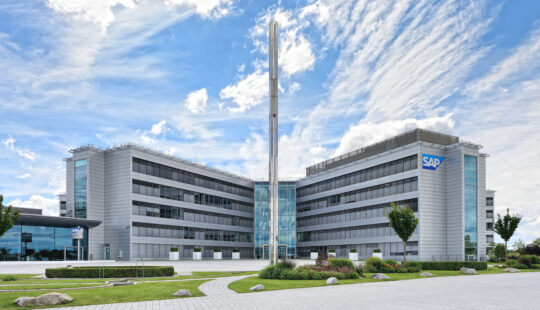It all started with a plane flight. At age seven, Karina Edmonds immigrated to the U.S. from the Dominican Republic with her family. “I remember getting on the plane,” she says. “I was fascinated that this big piece of metal could not only stay in the air, but also reach a predetermined destination. I always thought if I could figure out how that worked, I would be pretty smart.”
“My parents have very little education,” Edmonds says. “One of my sisters became a doctor, but I’m the only one in tech. I feel that, as the youngest, I had more opportunities than my sisters. But even so, I hit a wall in high school when I told my college counselor that I wanted to pursue a career in engineering and he advised me to consider a different career path.”
But Edmonds would not be deterred — not only did she get a degree in engineering, but also went on to pursue a PhD in aeronautics. “The space industry seemed fascinating. I did toy with the idea of becoming an astronaut but chose against it as I get motion sickness.”

Encouraging Historically Underrepresented Groups
“When I look back, I realize I didn’t have a lot of female role models in my personal life,” she says. “I looked toward outstanding people, such as Mae Jemison, the first African American woman in space.”
There were, however, supportive male professors. “My PhD supervisor was very empathetic and instrumental not only to my career, but also on a personal level. He recognized my struggle as the only female in the class to finish with a PhD. ‘I won’t even pretend to understand what it’s like standing in your shoes,’ he told me.”
In part, it was exactly this low percentage of women in science, technology, engineering, and mathematics (STEM) that led Edmonds to acquire a PhD. “I wanted to teach and encourage historically underrepresented groups,” she says. “That is still very important to me.” While she enjoys teaching, Edmonds found the research part of her academic career to be lonely.
“I’m a very outgoing person. There are many ways to serve as a role model. So, I decided to pursue a career in industry.” The percentage of women in the tech industry turned out to be just as low as it had been in academia, though. Edmonds was attracted to SAP because of its number of women in leadership roles.
A Career of Firsts
After graduating from the California Institute of Technology with her PhD, Edmonds joined Northrop Grumman, then known as TRW, where she worked in programs for the automotive industry and the U.S. Air Force. She also filed her first patent, for a noise reduction system in the automotive environment.
“Eventually, I felt I’d exhausted all my options,” Edmonds says. “And then a job became available at the Jet Propulsion Laboratory in the field of technology transfer.” This newly created role turned out to be perfectly aligned with Edmonds’ personal and technical skills.
“Technology transfer is all about relationship building,” she says. “It covers the whole process of taking a scientific discovery from the lab to the marketplace.”
Under the Obama administration, Edmonds joined the U.S. Department of Energy as the first person in the role of technology transfer coordinator.
“I find that in my career path I had this very common denominator: being the first to many of my roles. Later, with Google, I was the first person to start a university relations function in Cloud. Every time I’ve come in and created the role from the biggest pain points and built relationships from there. This is the heart of a lot the work that I’ve done.”
Growing the SAP Brand in the Academic Sphere
Edmonds says, “For much of my career I’ve supported faculty and researchers, and I feel I have a keen awareness of their needs and interests. But I also understand what is needed by the business side.”
A month into her new role as head of Academies and SAP University Alliances, Edmonds describes what she sees as the greatest opportunity: “In Germany and many other parts of the world, SAP is very well known among students and faculty, but I feel I’m uniquely qualified to strengthen SAP’s brand in North America in the academic fields of engineering and computer science.”
Promoting the brand is important in multiple ways, she explains: “The challenge for SAP is that we’re not a consumer-facing company, so unfortunately a lot of students are not aware of the brand even though they’ve likely used our products.”
Edmonds’ organization works closely with the Human Resources group at SAP and SAP Labs to create initiatives for the early talent pipeline. “Hiring top students is important, but regardless of where they later actually go to work, we want them to know about SAP products and services. They can serve as customers in the future.” On the Academies side, there are numerous opportunities to partner with the Customer Success organization around market needs.
Encouraging historically underrepresented groups in tech is still very close to Edmonds’ heart. She points out that compared to other technology companies SAP hires from a broad range of disciplines, such as communications, sales, and marketing. “I see that as an opportunity to make women feel more welcome and included. Even if they’re not in STEM, there’s a lot of opportunity in our company.”
A Mission that Speaks: Joining SAP
“I chose to join SAP because of what the company stands for: helping the world run better and improving people’s lives. Also, the level of support and interest from the Board convinced me that this is a company I want to join,” Edmonds says.
“What drives me is the idea that technology can give people all over the world the possibility to be part of the conversation. I want to expose young people to technology and to careers in technology. I feel this resonates very strongly with SAP’s approach to corporate responsibility. Helping the world run better and improving people’s lives is a mission that really spoke to me, and it speaks to early talents and other potential employees as well.”



